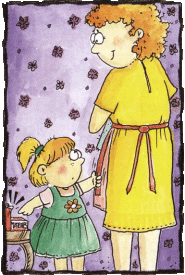Burns: How Can I Prevent Them?
WHAT IS A BURN?
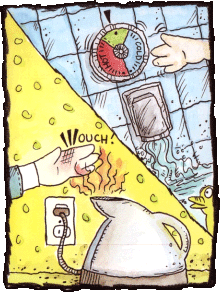 Young children and older adults are particularly vulnerable to burns. Hot liquids, not fire, are the most common cause of burns. Every year thousands of children are treated in emergency departments for burn injuries caused by hot tap water and other liquids.
Young children and older adults are particularly vulnerable to burns. Hot liquids, not fire, are the most common cause of burns. Every year thousands of children are treated in emergency departments for burn injuries caused by hot tap water and other liquids.
A burn is the destruction of skin cells and/or tissue. Most people identify burns in terms of degree:
First-degree burns (superficial) are minor and heal fast.
Indicators: red and dry, no blisters. Examples: sunburn, scald, and flash flame.
Second-degree burns (partial thickness) may require immediate medical attention.
Indicators: moist blisters
Examples: contact with hot liquids or solids, flash flame, chemicals.
Third-degree burns (full thickness) are extremely serious and require immediate medical attention.
Indicators: charred tissue, dry and leathery. Examples: contact with hot liquids or solids, flames chemicals or electrical.
HOW DO I TREAT A BURN?
- Immediately cool a burn by placing it under cool water for 10-15 minutes. Cool water reduces skin damage and minimizes pain.
- NEVER use butter, lotions, ice or ointments. This only seals the heat in.
- Don't break blisters. This could cause infection.
- After cooling, apply a clean, dry dressing to first-degree burns. Second and third-degree burns require immediate medical treatment.
HOW DO I PREVENT MY CHILDREN FROM GETTING BURNED?
- Educate your children that hot things can cause burns.
- Keep children at a safe distance when you pour or drink hot liquids.
- Never leave hot liquids or foods unattended or where a child may pull them down.
- When running a bath, always turn the cold water on first and then add hot water until the temperature is comfortable.
- Check the water temperature before putting your child into the bathtub.
-
Never leave children unattended in the bathtub. Not even for a second!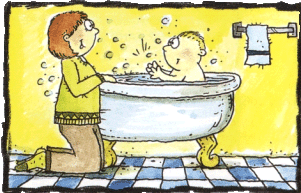
Never leave children unattended in the bathtub. - Teach your children when using a tap to always turn the cold water on first. When turning the taps off, reverse the procedure by turning the hot water off first.
- Keep appliances such as irons out of children's reach.
- Maintain constant supervision when barbecuing and during outdoor cookouts.
- Install child guards on all unused electrical outlets.
- Replace any damaged electrical cords.
IS THERE ANYTHING ELSE I NEED TO KNOW?
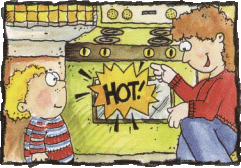 |
| Teach children safety in the kitchen. |
In the Kitchen
- Keep children at a safe distance from the cooking area.
- Never leave cooking unattended. Oil or fat can easily ignite.
- Turn elements off when you are finished cooking.
- Pot handles should always be turned toward the back of the stove.
- Wear short or tight fitting sleeves to prevent them from dangling into flames or contacting hot elements.
- Always use oven mitts or potholders when lifting hot objects.
Microwave Ovens
- When using the microwave ovens use extreme caution as food and liquids can overheat causing serious burns.
- Read and follow your microwave oven instruction manual on cooking times.
- When heating water in a cup, keep the cooking time to less than 2 minutes and stir frequently. This will prevent overheating.
Hot Water Heaters
- The thermostat on your water heater should be set at no more that 49° C (120° F).
NOTE: A serious burn can occur in 30 seconds at 55° C (131° F). At 60° C (140° F), it takes only 5 seconds. For children under the age of 5 and some adults over 65, it can take half as long to cause a serious burn.
|
Matches and Lighters
|
If Your Clothes Catch on Fire
- Stop, Drop to the floor, cover your face with your hand, and Roll. Keep rolling until the flames are out.
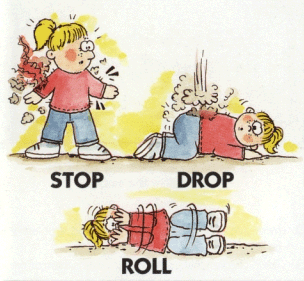 |
| STOP...DROP...AND ROLL!! |
| Sponsored By: | ||||
 |
 |
 |
 Insurance InsuranceBrokers Association |
 |
| Greater Vancouver Fire Chiefs Association Public Education Committee | ||||

